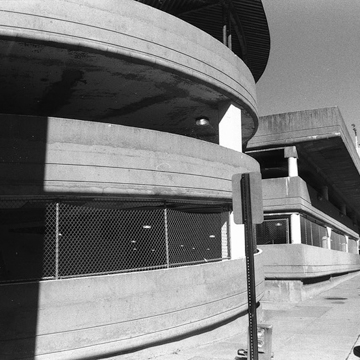Described in a 1957 Wilmington newspaper as “an answer to the harassed motorist's prayer,” this 522-car Wilmington Parking Authority garage addressed the postwar commuter crisis by clearing an entire block. The facility was so novel, the public had to be educated about using its spiraling ramps and obeying an elaborate system of signs and warning lights. Treadles electronically counted the number of cars entering (it was only the sixth garage in the world to do this). Each level had a color (white, yellow, blue, green), as “color technicians insist that feminine users will remember the color of the floor they are on.” The garage itself was of unpainted concrete and gray bricks, but the 9th Street facade housing retail establishments (originally Eagle Restaurant and Epicure Shop) was supported by piers clad in polished granite, with “Mid-Town Parking Center” in aluminum cursive letters above. An important desegregation case argued before the U.S. Supreme Court in 1961, Burton v. Wilmington Parking Authority and the Eagle Coffee Shoppe, was brought by an African American man who was denied a cup of coffee here in August 1958.
You are here
Mid-Town Parking Center
If SAH Archipedia has been useful to you, please consider supporting it.
SAH Archipedia tells the story of the United States through its buildings, landscapes, and cities. This freely available resource empowers the public with authoritative knowledge that deepens their understanding and appreciation of the built environment. But the Society of Architectural Historians, which created SAH Archipedia with University of Virginia Press, needs your support to maintain the high-caliber research, writing, photography, cartography, editing, design, and programming that make SAH Archipedia a trusted online resource available to all who value the history of place, heritage tourism, and learning.















